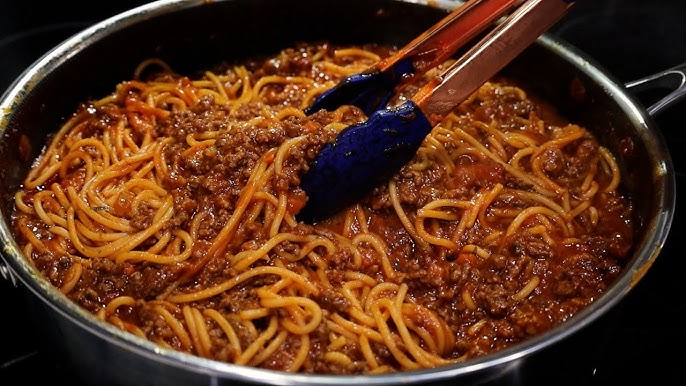Spaghetti Meat Sauce Recipe: There’s something irresistibly comforting about a hearty bowl of spaghetti topped with a rich, savory meat sauce. It’s a meal that pleases just about everyone—kids, adults, even picky eaters. What makes this dish so special? It’s simple, it’s satisfying, and it’s packed with flavor. Whether you’re feeding a crowd or just cooking for yourself, this recipe has you covered.
Most families have their own version of spaghetti meat sauce. Some add more herbs, others throw in extra vegetables, and a few swear by a dash of sugar to cut the acidity. But the beauty of this recipe lies in its flexibility. It’s like a blank canvas—you can customize it as you like. Plus, it’s one of those dishes that gets better the next day, making leftovers a true delight.
The meaty richness paired with the tang of tomatoes and the aromatic punch of garlic and onions creates a harmony of taste that makes this sauce a timeless classic. It’s not just food—it’s a tradition passed from generation to generation.
History and Origins of Spaghetti Meat Sauce
You might associate spaghetti with Italy—and you’d be right to do so. However, the classic meat sauce most Americans know and love is more of an Italian-American invention than a traditional Italian recipe. In Italy, Bolognese is the closest cousin, and it’s typically served with tagliatelle, not spaghetti.
Italian immigrants brought their culinary traditions to the U.S., where they adapted them based on available ingredients. Ground beef was more accessible and affordable in America, so it became a key ingredient. Tomatoes, abundant and flavorful, became the base of the sauce. Over time, what we now call spaghetti meat sauce evolved—simple, hearty, and designed to feed big families on a budget.
Ingredients You’ll Need
Essential Ingredients for a Flavorful Sauce
A great meat sauce starts with quality ingredients. Here’s what you’ll need:
- 1 lb ground beef or ground pork (or a mix of both)
- 2 tablespoons olive oil
- 1 medium onion, finely chopped
- 4 cloves garlic, minced
- 1 can (28 oz) crushed tomatoes
- 2 tablespoons tomato paste
- 1 teaspoon sugar
- 1 teaspoon salt (adjust to taste)
- ½ teaspoon black pepper
- 1 teaspoon dried oregano
- ½ teaspoon dried basil
- ½ teaspoon red pepper flakes (optional, for heat)
- ½ cup beef broth or water
- Fresh parsley or basil (for garnish)
These ingredients work together to create a deep, savory flavor. The sugar balances out the acidity of the tomatoes, while the herbs add depth and aroma.
Optional Add-Ins to Elevate the Dish
Want to customize your sauce? Here are some optional add-ins:
- Red wine – Adds richness and complexity.
- Grated carrots or celery – For a touch of sweetness and texture.
- Mushrooms – Earthy flavor that complements the meat.
- Bay leaves – For added aroma during simmering.
- Parmesan rind – Infuse the sauce with cheesy umami.
Adding these extras can elevate your sauce from good to gourmet. Don’t be afraid to experiment—make it your own!
Kitchen Tools You’ll Need
Basic Utensils and Cookware
Before you get started, gather your tools:
- Large skillet or Dutch oven – For browning meat and simmering sauce.
- Pot for boiling pasta
- Wooden spoon or spatula – To stir and break up the meat.
- Knife and cutting board – For prepping ingredients.
- Colander – To drain your pasta.
Having the right equipment makes the cooking process smoother and more enjoyable.
Tips for Efficient Cooking Prep
To make your cooking process stress-free, follow these prep tips:
- Chop all vegetables before you start cooking.
- Measure out spices and seasonings in small bowls.
- Have your pasta water ready to boil while the sauce simmers.
- Grate cheese in advance if you’re using any.
Prepping ahead not only saves time but also ensures you don’t miss a beat during the cooking process.
Step-by-Step Instructions
Step 1: Preparing Your Ingredients
Before you even turn on the stove, take a few minutes to prep everything. Dice your onions, mince your garlic, and measure your seasonings. If you’re using optional vegetables like mushrooms or carrots, prep those too. This step might seem small, but it sets the stage for smooth, efficient cooking.
Once everything is ready, take out your ground meat and let it sit at room temperature for about 10–15 minutes. This helps it cook more evenly. If you’re using frozen meat, make sure it’s fully thawed. The key to great flavor is starting with fresh, well-prepped ingredients.
Step 2: Cooking the Meat to Perfection
This step is where the foundation of your flavor begins. Heat your skillet or Dutch oven over medium-high heat and add the olive oil. Once it shimmers, toss in the chopped onions and cook until they’re soft and translucent—about 5 minutes. Stir in the garlic and cook for an additional minute, just until fragrant. Be careful not to burn it; burnt garlic can give your sauce a bitter taste.
Now, it’s time to add your ground meat. Break it up with a wooden spoon as it browns. You want the meat to cook evenly and develop a deep brown crust in spots—that’s where the flavor lives. Don’t rush this part. Browning creates a rich umami depth that’s absolutely essential to a great meat sauce.
Once the meat is fully cooked and you’ve got some nice caramelized bits, drain any excess fat if necessary. If you’re using lean meat, there might not be much to drain. Add a pinch of salt and pepper to season the meat directly. Stir everything together to let the flavors meld before moving on.
Step 3: Simmering the Sauce
Here’s where the magic happens.
Reduce the heat to medium-low and add the tomato paste. Stir it into the meat and let it cook for 2–3 minutes. This deepens the tomato flavor and caramelizes the paste a little, which adds sweetness and richness to your sauce.
Next, pour in the crushed tomatoes, beef broth or water, and all your herbs—oregano, basil, red pepper flakes (if using), and sugar. Stir everything together well. Add a little more salt and pepper at this point, but go easy. You can always adjust later.
Bring the sauce to a gentle simmer. You’ll want to see occasional bubbles, not a full-on boil. Let it simmer uncovered for 20–30 minutes, stirring occasionally. If it starts to get too thick, just add a splash of water or broth.
As it simmers, the flavors will marry together beautifully. The meat will soften, the sauce will thicken, and your kitchen will start to smell like heaven. Don’t forget to taste and adjust your seasonings along the way. If it tastes too acidic, a small pinch of sugar can help. Want it richer? Add a bit more olive oil or a dab of butter.
Step 4: Boiling the Spaghetti
While your sauce simmers, it’s time to cook the pasta. Bring a large pot of water to a rolling boil. Add a generous amount of salt—think ocean water level. This is your only chance to season the pasta itself.
Add the spaghetti and cook according to the package directions until it’s al dente, which means it still has a slight bite. Don’t overcook it—no one likes mushy noodles!
Once done, reserve about a cup of the starchy pasta water (you might need it to loosen your sauce later), then drain the spaghetti in a colander. Do not rinse the pasta. That starchy coating helps the sauce cling to it like glue.
You can either mix the spaghetti directly into the sauce or serve it plated with the sauce spooned generously on top. If you’re mixing them, toss them together in the pot with a bit of pasta water for a silky, restaurant-quality finish.
Step 5: Mixing and Serving
Now the best part—bringing it all together.
If you prefer the pasta and sauce mixed, add the drained spaghetti into your sauce pot. Toss it over low heat for a minute or two to let the noodles soak up all that flavor. Add a splash of reserved pasta water if needed to thin it slightly and help the sauce cling better.
If you like serving your pasta with sauce ladled on top (the traditional Italian-American way), place a generous portion of spaghetti on each plate and spoon the meat sauce over it.
Top with freshly grated Parmesan cheese, chopped parsley or basil, and maybe a drizzle of good olive oil for that extra touch. Want to get fancy? Serve with a side of garlic bread and a simple green salad.
This is the moment you’ve been waiting for—dig in and enjoy every bite.
Tips for the Best Spaghetti Meat Sauce
Common Mistakes to Avoid
- Not browning the meat properly – That golden-brown sear gives the sauce its depth.
- Skipping the simmer – You need that low and slow cook to blend all the flavors.
- Overcooking or undercooking the pasta – Al dente is your best friend.
- Undersalting the pasta water – Your noodles need flavor, too.
- Rushing the garlic – Burnt garlic will overpower everything.
Avoiding these pitfalls makes the difference between an average dinner and a wow-worthy meal.
Flavor Enhancing Secrets from Chefs
- Deglaze the pan with a splash of red wine after browning your meat for deeper flavor.
- Add a Parmesan rind to the sauce while it simmers—it melts in and boosts umami.
- Use a mix of meats like beef, pork, and even a bit of Italian sausage for complexity.
- A dash of balsamic vinegar at the end can brighten and balance the sauce.
- Let it rest for 10 minutes before serving. Just like stew, it tastes even better when it’s had time to settle.
FAQs about Spaghetti Meat Sauce Recipe
1. Can I use ground turkey instead of ground beef?
Absolutely! Ground turkey is a leaner alternative and still gives a rich, meaty flavor. Just make sure to season well since it’s milder than beef.
2. How long does spaghetti meat sauce last in the fridge?
It can last up to 4 days when stored in an airtight container in the fridge. For longer storage, freeze it for up to 3 months.
3. Can I freeze the sauce for later?
Yes! Let the sauce cool completely, then store it in freezer-safe bags or containers. Thaw overnight in the fridge and reheat on the stove or microwave.
4. What’s the best pasta to pair with meat sauce?
Spaghetti is classic, but you can also use linguine, fettuccine, penne, or even rigatoni. Just make sure it holds up to the hearty sauce.
5. Should I drain the fat after browning the meat?
Yes, especially if you’re using regular ground beef (80/20). Draining excess fat helps prevent a greasy sauce and keeps it lighter.
6. Can I make it in a slow cooker?
Definitely. Brown your meat first, then add all ingredients into the slow cooker and simmer on low for 6-8 hours. The flavors meld beautifully over time.
Conclusion
Spaghetti with meat sauce isn’t just a meal—it’s an experience. It’s that nostalgic aroma that takes you back to grandma’s kitchen, the comfort after a long day, and the joy of sharing a table with the people you love. Whether you’re a first-time cook or a seasoned kitchen pro, this recipe is your ticket to a homemade Italian-American classic that never goes out of style.
Simple ingredients, step-by-step instructions, and a whole lot of flavor—that’s what this spaghetti meat sauce recipe delivers. Make it once, and it might just become your go-to pasta night favorite.



